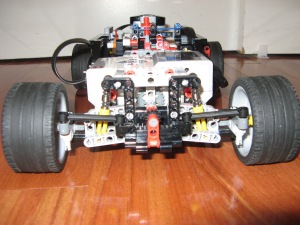Hello! I would like to first apologize for not posting for many months now; I was very busy. Now I have returned with what I think is my greatest project yet, the Plethora II, which is a remote-controlled EV3 racecar. Featured in this second iteration of the Plethora racecar is a new rear-wheel drive system with a 4-speed sequential automatic transmission and all-wheel independent suspension. Keep reading to learn more about the inner workings! (It’s a lot of information, so feel free to just skim through!)
See a video of the Plethora II here: https://www.youtube.com/watch?v=HnJGR7NyBXQ
Body Shell
The first great thing about the body shell is that it can be easily removed from the Plethora II’s chassis in one piece. However, this body shell is only for modeling purposes as it adds a lot of unnecessary weight. I personally think this body shell is much more appealing than that of the previous Plethora. (I designed this one with my glasses on!!!;) This body shell features an opening hood, easy access to all of the internals and my favorite part: a fully articulated, (manually)folding convertible roof. (Why not, right?) The whole roof opens and closes with just the turn of a lever.
Suspension and Steering
The Plethora II is my first-ever model to feature all-wheel independent suspension. (It was somewhat difficult considering I do not have any of the specialty elements at my disposal.) The suspension members somewhat resemble wishbone suspension. This system works good, but does not have a lot of travel, mostly because the Plethora II is very low to the ground. With that being said, the rack-and-pinion steering system used in the Plethora II is all new, the first one compatible with the independent suspension. I had accidentally created steering that has a slight Ackerman affect and toe-in angle. The motor that drives the steering is an EV3 Medium motor hidden beneath the EV3 brick.
Drivetrain and Transmission
Two EV3 Large motors are used to move the Plethora II. In this vehicle, a rear-wheel drive system is used. The part I am most excited to share with you is the transmission! The transmission is a 4-speed sequential synchromesh automatic. The design draws inspiration from Sheepo, but I’m not sure how similar our designs are, if at all. Anyway, since the transmission is sequential, it only needs a single Medium motor to select gears! Here’s how it works: the Medium motor uses the 13 module rack gear from the EV3 Expansion Set to move a slider forward or backward. When the slider is all the way back, 1st gear is locked in. Moving the slider forward will make the transmission activate each of the gears in order, all the way to 4th, in the forward-most position. The gears are activated by a piece (shown in orange in the pictures). This orange piece is spring-loaded with 3 red rubber bands and presses down on a paddle to lock the synchromesh into gear. I have spent a considerable amount of time tweaking the slider to make shifting as smooth as possible.
Programs
The Plethora II has three programs, all of which are RC. The first program is Simple Drive. This program allows the user to control the steering and throttle of the car, but not shifting. The steering is more difficult to program with an EV3 than you may think; I created a MyBlock to steer the car’s front wheels in one direction. The second program is Drive Manual. This program has all of the features of Simple Drive, and grants the user complete control over gear shifting. (You must use a second remote control to shift the gears.) This program utilizes the Touch sensor to reset the shifter to 1st gear at the beginning of the program and to prevent the user from downshifting when in first gear. The last cool feature of Drive Manual are the Shift Indicator Lights; the EV3 brick lights are programmed to change color from red, to orange, to green to let the user know when the best time to shift is. The Indicator Lights are controlled by the RPM of the motors, read by the HiTechnic Angle sensor. The final program is Drive Auto, which allows the user to control throttle and steering, like in Simple Drive, but shifting of the transmission is controlled by the EV3 brick. The heart of Drive Auto is the Shifting MyBlock, shown in the fifth picture. This MyBlock reads the RPM off the motors from the HT Angle sensor, and makes the decision to upshift, hold gear, or downshift. Drive Auto has all of the Touch sensor safety and reset mechanisms of Drive Manual.
Conclusion
The Plethora II was built, torn apart and rebuilt at least five times in hopes of fixing major flaws with each rebuild. I have spent hours tweaking the transmission shifting to get it up to my standards. The programs are the most complex of anything I have made. And, on top of that, the Plethora II packs in tons of other mechanical features in such a small area, utilizing every cubic centimeter of space. With that being said, I think the Plethora II is a huge success in achieving its goal and then some. These suspension and transmission systems will likely make their way into future projects. I hope you enjoyed reading about the Plethora II and, as always, thanks for reading!








is very cool
Thanks! I worked on this one for a long time!